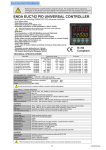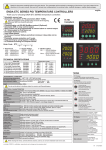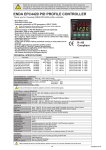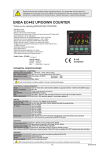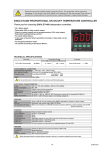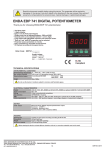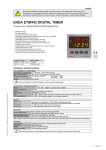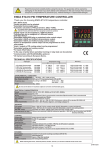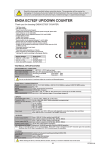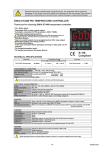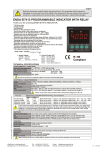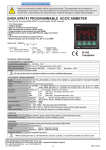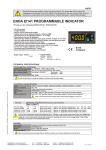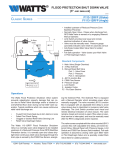Download ENDA ETC4420 PID TEMPERATURE CONTROLLER
Transcript
Read this document carefully before using this device. The guarantee will be expired by damaging of the device if you don't attend to the directions in the user manual. Also we don't accept any compensations for personal injury, material damage or capital disadvantages. ENDA ETC4420 PID TEMPERATURE CONTROLLER Thank you for choosing ENDA ETC4420 temperature controller. * 48 x 48mm sized. * Selectable sensor type. * Automatic calculation of PID parameters (SELF TUNE). Enter PID parameters of the system if they are known at the beginning. Otherwise, Self-Tune should be activated. * Soft-Start. * Communication vai RS-485 ModBus protocol (Optional). * Selectable SSR or relay control output. * Relay output can be programmable as second alarm or control output. * AL1 relay output for first alarm out. * Selectable Heat/Cool control. * Input offset feature. * In the case of sensor failure periodical running or relay state can be selected. * Parameter access protection on 3 levels. * Programming by using keypad or Modbus. * CE marked according to European Norms. ETC 4420 CNT/AL2 SSR PV AL1 SV SET CSET ENDA ASET TEMPERATURE CONTROLLER TECHNICAL SPECIFICATIONS Input type Pt 100 Resistance Thermometer Pt 100 Resistance Thermometer J (Fe-CuNi) Thermocouple K (NiCr-Ni) Thermocouple T (Cu-CuNi) Thermocouple S (Pt/0Rh-Pt) Thermocouple R (Pt13Rh-Pt) Thermocouple EN 60751 EN 60751 EN 60584 EN 60584 EN 60584 EN 60584 EN 60584 Temperature range °F °C -200...600 °C -328... +1112 °F -99.9...300.0 °C -99.9...+543.0°F 0... 600 °C +32... +1112 °F 0...1200°C +32... +2192 °F 0... 400°C +32... +752 °F 0...1600°C +32... +2912 °F 0...1600°C +32... +2912°F Accuracy 0,2% (of full scale) 0,2% (of full scale) 0,2% (of full scale) 0,2% (of full scale) 0,2% (of full scale) 0,2% (of full scale) 0,2% (of full scale) 1 digit 1 digit 1 digit 1 digit 1 digit 1 digit 1 digit ENVIRONMENTAL CONDITIONS Ambient/storage temperature 0 ... +50°C/-25... +70°C (with no icing) Max. Relative humidity 80% up to 31°C decreasing linearly 50% at 40°C . According to EN 60529 Front panel : IP65 Rated pollution degree Rear panel : IP20 Height Max. 2000m Do not use the device in locations subject to corrosive and flammable gases. ELECTRICAL CHARACTERISTICS Supply Power consumption Wiring Line resistance Data retention EMC Safety requirements 230V AC +10% -20%, 50/60Hz or 24V AC ±10%, 50/60Hz. Max. 5VA 2.5mm² screw-terminal connections For thermocouple max.100ohm, for 3 wired Pt 100 max. 20ohm EEPROM (minimum 10 years) EN 61326-1: 1997, A1: 1998, A2: 2001 (Performance criterion B for standard EN 61000-4-3) EN 61010-1: 2001 (Pollution degree 2, overvoltage category II) OUTPUTS CONT./AL2 AL1 SSR out Life expectancy for relay Relay : 250V AC, 2A ( for resistive load), NO/NC. Selectable as Control or Alarm2 output. Relay : 250V AC, 2A ( for resistive load), NO/NC selectable. (Alarm1 output). Selectable logic control output. (Max 12V 20mA( Mechanical 30.000.000 operation; Electrical 300.000 operation CONTROL Control type Control algorithm A/D converter Sampling time Proportional band Integral time Derivative time Control period Hysteresis Output power Single set-point and alarm control On-Off / P, PI, PD, PID (selectable) 15 bits 500ms Adjustable between 0% and 100%. If Pb=0%, On-Off control is selected. Adjustable between 0.0 and 100.0 minutes Adjustable between 0.00 and 25.00 minutes Adjustable between 1 and 250 seconds Adjustable between 1 and 50°C/F The ratio of power at a set point can be adjusted between 0% and 100% HOUSING Housing type Dimensions Weight Enclosure material Suitable for flush-panel mounting according to DIN 43 700. W48xH48xD87mm Approx. 250g (after packing) Self extinguishing plastics. While cleaning the device, solvents (thinner, benzine, acid etc.) or corrosive materials must not be used. 1/4 ETC4420-E-02-R SET ASET CSET key is pressed while holding ASET key, the programming mode is enabled. CSET Con.o. ASET Pb 4 Pb = Proportional band. Adjustable between 0% and 100% Setting Pb = 0% On-Off control is selected. A1.Hy. 2 A1.Hy. = Hysteresis of the Alarm1 output. Adjustable between 1 and 50°C. tý 4.0 Ti = Integral time. Adjustable between 0.0 and 100.0 minutes. If ti = 0.0, integral effect is not used. Setting Pb = 0 this parameter is not seen. A1.tp. ýndE. A1.tP. = td 1.00 Ct 20 P.SEt. 0 C.HyS. 2 td = Derivative time. Adjustable between 0.00 and 25.00 minutes. If td = 0.00, derivation effect is not used. Setting Pb = 0 this parameter is not seen. C.oT.S. Out1 S.S.T.S. 0 Adjustable between 1 and 250 seconds. Setting Pb = 0 and C.ot.S.= Out1 this parameter is not seen. P.SEt. = The ratio of output power at the set point.Adjustable between 0% and 100%. If this parameter is set to 0, the output power becomes 0 at the set point. If it is adjusted to 50% output power becomes 50% at the set point. Using this parameter the energy requirements of the system is adjusted at the set point. So the set point can be achieved by minimum fluctuations and in the shortest time.Setting Pb = 0, this parameter is not seen. C.HYS. = Hysteresis of the control output. Adjustable between 1 and 50 °C/F. Setting Pb = 0 this parameter is seen. Pr.Er. = This parameter is used to adjust the control output during a sensor failure. Adjustable between 0% and 100%. If this parameter is adjusted to a value closer to the energy requirements of the system at the set point, process temperature is prevented to rise or drop to dangerous levels. C.ot.S. = Type of control output Out1 = Out1 is control output. S.s.r = SSr control output. Out1 = Alarm2 output. SET S.S.t.S. = Soft Start timer set point value This parameter indicates the time to reach set point value when the device is first energized. Adjustable between 0 and 250 minutes. If 0 is selected, soft start feature will be enable and the device reaches set point value quickly. NOTE! Setting Pb = 0, soft start feature will be disable. CSET C.HyS. 6 SET CSET C.HyS. 5 SET CSET C.HyS. 6 SET CSET SET When holding key, the value of parameter flashes and using CSET keys the requested value can be adjusted. If A1.P.e. oFF A1.p.e. = State of Alarm1 output in the case of sensor failure. If A1.p.e.= On , the alarm output is energized during the sensor failure. If A1.p.e.= oFF, the alarm output is not energized during the sensor failure. A2.Hy. 2 A2.Hy. = Hysteresis of the Alarm2 output. Adjustable between 1 and 50°C. NOTE! If C.ot.S. =.out1, this parameter is not seen. A2.tP. = Function of Alarm2 output. Four kinds of functions can be selected. indE. = Independent dE. = Deviation bAnd = Band bAn.i. = Band with inhibition NOTE! If C.ot.S. = .out1, this parameter is not seen. A2.tp. ýndE. A2.St. A2.St. = The state of Alarm2. Hý. If independent or deviation alarm is Modification Of Parameter Diagram C.HyS. 6 selected, this parameter can be Lo. and Hi. For Lo. alarm output is energized below the alarm set point. For Hi. alarm output is energized above the alarm set point. If band alarm is selected, this parameter can be bIHI or boHI. bIHI means alarm is activated inside the band.boHI means alarm is activated outside the band. Ct = Control period. C.Hi.L. = Set point upper limit. If InP. or UnIt. parameters are changed, the maximum value of the C.Hi.L. parameter changes to the maximum scale value of the selected input. The minimum value is the value of C.Lo.L. parameter. C.Lo.L. 0 C.LoL. = Set point lower limit. selected, this parameter can be Lo. and Hi. For Lo. alarm output is energized below the alarm set point. For Hi. alarm output is energized above the alarm set point. If band alarm is selected, this parameter can be bIHI or boHI. bIHI means alarm is activated inside the band. boHI means alarm is activated outside the band. NOTE! If C.ot.S. = .out1, this parameter is not seen. A2.P.e. A2.p.e. = State of Alarm2 output in the of sensor failure. oFF case If A2.p.e.= On, the alarm output is energized during the sensor failure. If A2.p.e.= oFF, the alarm output is not energized during the sensor failure. NOTE! If C.ot.S. = .out1, this parameter is not seen. oFFS. 0 Unit. °C A1.H.L. 600 ASET If InP. or UnIt. parameters are changed, the minimum value of the C.Lo.L. parameter changes to the minimum scale value of the selected input. The maximum value is the value of C.Hi.L. parameter. S.Str. run S.cod. 0 A.Con. P.yES SET CSET Yes Process value is equal or lower than 60%of the set point ? A1.L.L. 0 A1.L.L. = Alarm1 value lower limit. If InP. or UnIt. parameters are changed, the minimum value of the A1.L.L. parameter changes to the minimum scale value of the selected input type. The maximum value is the value of A1.H.L. parameter. A2.H.L. 600 A2.H.L = Alarm2 value upper limit. If InP. or UnIt. parameters are changed, the maximum value of the A2.H.L. parameter changes to the maximum scale value of the selected input type. Minimum of A2.H.L. parameter is the value of A2.L.L. parameter. NOTE! If C.ot.S. = .out1, this parameter is not seen. A2.L.L. A2.L.L. 0 = Alarm2 value lower limit. If InP. or UnIt. parameters are changed, the minimum value of the A2.L.L. parameter changes to the minimum scale value of the selected input type. The maximum value is the value of A2.H.L. parameter. fL.Co. 5 fL.Co. = Coefficient of digital filter. Filter for display value. Adjustable between 1 and 32. If this parameter is 1, digital filter runs most quick. If the parameter is 31, the filter run most slow. The value of parameter should be increased in interference. d.adr. 1 d.adr. = Device address. Adjusable between 1 and 247. Difference addresses should be selected for every device. baud Baud= Modbus baud rate. off Selectable 1200, 2400, 4800 and 9600. If baud= off, Modbus communication will be disable. A.Con. = Parameters of CoN.o menu access level code. nonE = Invisible P.yES = Modification can be done. P. no = Only visible. P.yES = Modification can be done. P. no = Only visible. A.CNF. A.CNf. = Parameters of ConF. menu access level code. P.yES nonE = Invisible P.yES = Modification can be done. P. No = Only visible. No 70 TE.Hý. A.tun. yES UnIt = The temperature unit. Selectable as °C or °F. Note : If the temperature unit is changed, the value of the UPL., Lol., A.UP.L., A.Lo.L. Parameters changes automatically. NOTE! IfInp parameter is selected TC or Pt100, this parameter is seen. A1.H.L = Alarm1 value upper limit. If InP. or UnIt. parameters are changed, the maximum value of the A1.H.L. parameter changes to the maximum scale value of the selected input type. Minimum of A1.H.L. parameter is the value of A1.L.L. parameter. S.cod. = Security menu access code. It should be 666. A.ALr. A.ALr.. = Parameters of ALr.o menu access level code. P.yES nonE = Invisible oFFS. = Offset value. Offset value is added to the measurement value. Adjusted between -99 and +99°C.The normal value is 0. ASET Before starting sef-tune procedure, be sure A.tun parameter is YES in the SECU menu. inP. = Type of input and scale. Pt = Pt 100 -200 to +600°C Pt.0 = Pt 100 -99.9 to +300.0°C FE.cn. = J (Iron vs. Copper-Nickel) 0 to +600°C nc.nA. = K (Nickel-Cr.vs. Nickel-Alum.) 0 to +1200°C c.cn. = T (Copper vs. Copper-Nickel) 0 to +400°C P10.r. = S (Platinum-10%Rhodium vs. Pt.) 0 to +1600°C P13.r. = R (Platinum-13%Rhodium vs. Pt.) 0 to +1600°C Note : If the selected input type is changed, the value of C.Hi.L, C.Lo.L , A.Hi.L., A.Lo.L. parameters changes automatically. C.Hi.L. 600 A1.St. A1.St. = The state of Alarm1. Hý. If independent or deviation alarm is C.StA. C.StA. = Configuration of the control output. C.StA. = HEAt means heating control. HEAt C.StA. = cooL means cooling control. Pr.Er. 0 Function of Alarm1 output. Four kinds of functions can be selected. indE. = Independent dE. = Deviation bAnd = Band bAn.i. = Band with inhibition ASET ýnP. FE.cn. ASET SECU. S.tun. ASET CSET CSET ASET ConF. ALr.o. ASET SET Entering from the programming mode to the run mode: If no key is pressed within 20 seconds during programming mode, the data is stored automatically and the run mode is entered. SET Alternatively, the same function occurs first pressing key and then pressing keys together. SET If 25 REdY. Press any key 25 Pýd.t. A.tun. = Parameters of S.tun. menu access level code. no = Invisible yES = Self tune can be done. After PID is calculated 25 P.SE.t. Press any key to deactivate the self-tune procedure. SET key, run message flashes. Then when While holding key is pressed, CSET self tune mode is entered if there is no probe failure. If process value is Appropriate to begin self tune, rEdY. message flashes. Then press any key to see Pid.t. message and self tune procedure begins.Process value must be equal or lower than 60%of the setpoint to begin self tune procedure. If not, tE.Hi. message flashes and device waits to decrease appropriate temperature to begin self tune. Then rEdY. message flashes and press any key to begin sellf tune procedure. Before self tune procedure, A.tun. parameter must be selected yES from the SECU menu.If self tune is achieved A.tun. parameter becomes no automatically and S.tun menu is canceled. Before self tune procedure, temperature setpoint value should be adjusted. When self tune procedure begins with no failure, Pid.t. message flashes and remains during the calculation of PID parameters. When PID parameters are calculated, P.SE.t. message flashes. Then the device heats until setpoint value according to PID parameters and calculates the energy requirement for stable temperature and writes P.SE.t. parameter as %and run mode enters. If any key is pressed while Pid.t. message flashes, self tune prosedure is deactivated before calculation of PID parameters. If any key is pressed while P.SE.t. message flashes, then self tune prosedure is deactivated as PID parameters are calculated and P.SE.t. parameter is done 0. key is pressed and held 0.6 seconds, the value of the selected parameter changes rapidly. If waited enough,the value increases 100 at each step. After 1 second following the release of the key, initial condition is returned.The same procedure is valid for the decrement key. 2/4 ETC4420-E-02-R TERMS ETC 4420 CNT/AL2 SSR (7) ( 1 ) Process value during normal operation Mnemonic parameter code during programming PV AL1 ( 2 ) Set point during normal operation. Data value during programming SV ( 3 ) Increment key during normal operation and programming Parameter selection key during programming ( 4 ) Decrement key during normal operation SET CSET If only this key is pressed in normal operation, software version number is seen. Parameter selection during programming ASET ENDA ( 5 ) Alarm set key during normal operation Menu selection key during programming TEMPERATURE CONTROLLER ( 6 ) Heat set key during normal operation Parameter selection key during programming ( 1 ) PV display ( 2 ) SV display 4 digits 7 segment red LED 4 digits 7 segment yellow LED PV display :7 mm SV display :7 mm Micro switch Character heights ( 3 ),( 4 ),( 5 ),( 6 ) Keypad ( 7 ) State indicator 3 red LEDs for Control, Alarm1 and SSR outputs ALARM1 AND ALARM2 OUTPUT TYPES Independent Alarm A1.tP.=indE SV Band Alarm A1.tP.= bAnd Deviation Alarm A1.tP.= DE. SV ON SV ON ON OFF OFF A.StA.= Hi ON ON ON OFF OFF A.StA.= Lo OFF a1.Hy. A1.St.= boHi OFF A1.Hy. A1.Hy.. A1.Hy. SV-ASV ASV SV+ASV +300 (ASV min = beginning of scale -300 ASV max = end of scale) (ASV min. =-300, ASV max. = +300) (IfinP = Pt..0, ASV min. = -30.0, ASV max. = +30.0) SV = Set point of CONT output ASV = Set point of alarm output A1.St.= biHi SV+ASV 300 300 SV =Set point of CONT output ASV = Set point of AL1 output (ASV min. = 0, ASV max. = +300) (IfinP = Pt..0, ASV min. = 0.0, ASV max. = +30.0) Band Alarm With Inhibition A1.tP.= BAn.i. SV+ASV SV+ASV SV SV SV-ASV SV-ASV ON OFF ON OFF Band alarm is possible Band alarm is possible Beginning Beginning of procedure of procedure SV =Set point of CONT output ASV = Set point of AL1 output (ASV min. = 0, ASV max. = 300 ) MODIFICATION OF CONTROL AND ALARM SET POINTS 130 150 PV C.SEt 150 SET SV CSET PV SET SV CSET C.SEt 149 PV SET SV CSET C.SEt 150 PV When CSET is released, it returns to normal operation. SET SV CSET SET key until the massage C.Set appears on the display. Then, the value is adjusted by using First, press and hold keys. CSET A1.sE. 250 PV SV ASET First, press and hold ASET ASET A1.sE. 249 PV SV ASET A1.sE. 250 PV SV ASET When ASET is released, it returns to normal operation. key, alarm setpoint value appears on the display. Then, the value is adjusted by using If C.ot.S different from out1. Alarm1 and Alarm2 setpoint values can be adjusted in sequence when per press keys. . key. ASET NOTE: The maximum of C.SEt is the value of C.Hi.L. parameter and the minimum of it is the value of C.Lo.L. parameter. If independent alarm is selected, A1.SE. and A2.SE.values can be adjusted between the limits of the full scale. If deviation alarm is selected, A1.SE. and A2.SE. values can be adjusted between -300 and +300. If band alarm is selected, A1.SE. and A2.SE. values can be adjusted between 0 and +300. ---150 Error Messages PV SV Temperature value is higher than the scale PV ---- SV 150 Temperature value is lower than the scale PFA 150 PV SV Temperature sensor is broken or over temperature 3/4 PSC 150 PV SV Pt 100 or a sensor line is short circuited ETC4420-E-02-R Depth DIMENSIONS 87mm 1 For removing the device from the panel: - While pressing both side of the device in direction 1, push it in direction 2. ETC 4420 CNT/AL2 48mm 58mm AN/SSR PV AL1 SV SET CSET ASET ENDA TEMPERATURE CONTROLLER 2 1 Connection cables Enviroment temperature measurement sensor Panel cut-out 51mm +0.6 mm 45 +0.6 mm 45 80mm Flush mounting clamp Panel Note 1) While panel mounting, additional distance required for connection cables should be considered. 2) Panel thickness should be maximum 9mm. 3) If there is no 100mm free space at back side of the device, it would be difficult to remove it from the panel. CONNECTION DIAGRAM ENDA ETC4420 is intended for installation in control panels. Make sure that the device is used only for intended purpose. The shielding must be grounded on the instrument side. During an installation, all of the cables that are connected to the device must be free of energy. The device must be protected against inadmissible humidity, vibrations, severe soiling and make sure that the operation temperature is not exceeded. All input and output lines that are not connected to the supply network must be laid out as shielded and twisted cables. These cables should not be close to the power cables or components. The installation and electrical connections must be carried on by a qualified staff and must be according to the relevant locally applicable regulations. ENDA INDUSTRIAL ELECTRONICS ENDA INDUSTRIAL ELECTRONICS ETC4420-24VAC PID TEMPERATURE CONTROLLER ETC4420-230VAC-RS PID TEMPERATURE CONTROLLER + - RS- 485 A 1 9 B 2 10 3 RS-485 COM. SSR OUT + - + TC Pt 100 - 4 5 11 12 6 13 7 14 8 15 230V AC +10% -20% 50/60Hz 5VA 1 9 2 10 3 SSR OUT CONT./AL2 AC 250V 2A RESISTIVE LOAD AL1 AC 250V 2A RESISTIVE LOAD SN: XXXXXXXXX + TC Pt 100 - + - 11 4 5 12 6 13 7 14 8 15 24V AC ±10% 50/60Hz 5VA CONT./AL2 AC 250V 2A RESISTIVE LOAD AL1 AC 250V 2A RESISTIVE LOAD SN: XXXXXXXXX Note 1) Mains supply cords shall meet the requirements of IEC 60227 or IEC 60245. 2) In accordance with the safety regulations, the power supply switch shall bring the identification of the relevant instrument and it should be easily accessible by the operator. Holding screw 0.4-0.5Nm NOTE : SUPPLY : 184-253V AC 9 or 99-121V AC 10 50/60Hz 5VA Logic output of the instrument is not electrically insulated from the internal circuits. Therefore, when using a grounding thermocouple, do not connect the logic output terminals to the ground. Line Fuse F 100 mA 250V AC Equipment is protected throughout by DOUBLE INSULATION. switch 230V or 24V AC Supply Neutral Fuse should be connected. SENSOR INPUT : + For J-K-T-S-R type thermocouple : Use suitable compensation cables. Don't use jointed cables. Pay attention to the polarities of the thermocouple cables as shown in the figure right are connected to the . TC 7 - 8 + - 6 For resistance thermometer : When 2 wired Pt 100 is used, terminals 6 and 7 must be short circuited. Order Code : ETC4420- - 1 Cable size: 1,5mm² Pt 100 7 2 1- Supply Voltage 230VAC...230V AC 24VAC.....24V AC SM...........9-30V DC / 7-24V AC 2- Modbus Option RS........RS-485 Modbus communication None....Don’t support RS-485 Modbus communication 8 SÝSEL MÜHENDÝSLÝK ELEKTRONÝK SAN. VE TÝC. A.Þ. Yukarý Dudullu Barbaros Cd. Kutup Sok. No:20 34775 - ÜMRANÝYE/ÝSTANBUL-TÜRKÝYE Tel : +90 216 499 46 64 Pbx. Fax : +90 216 365 74 01 4/4 url : www.enda.com.tr ETC4420-E-02-R




